2009 SUBARU TRIBECA fuel
[x] Cancel search: fuelPage 1744 of 2453
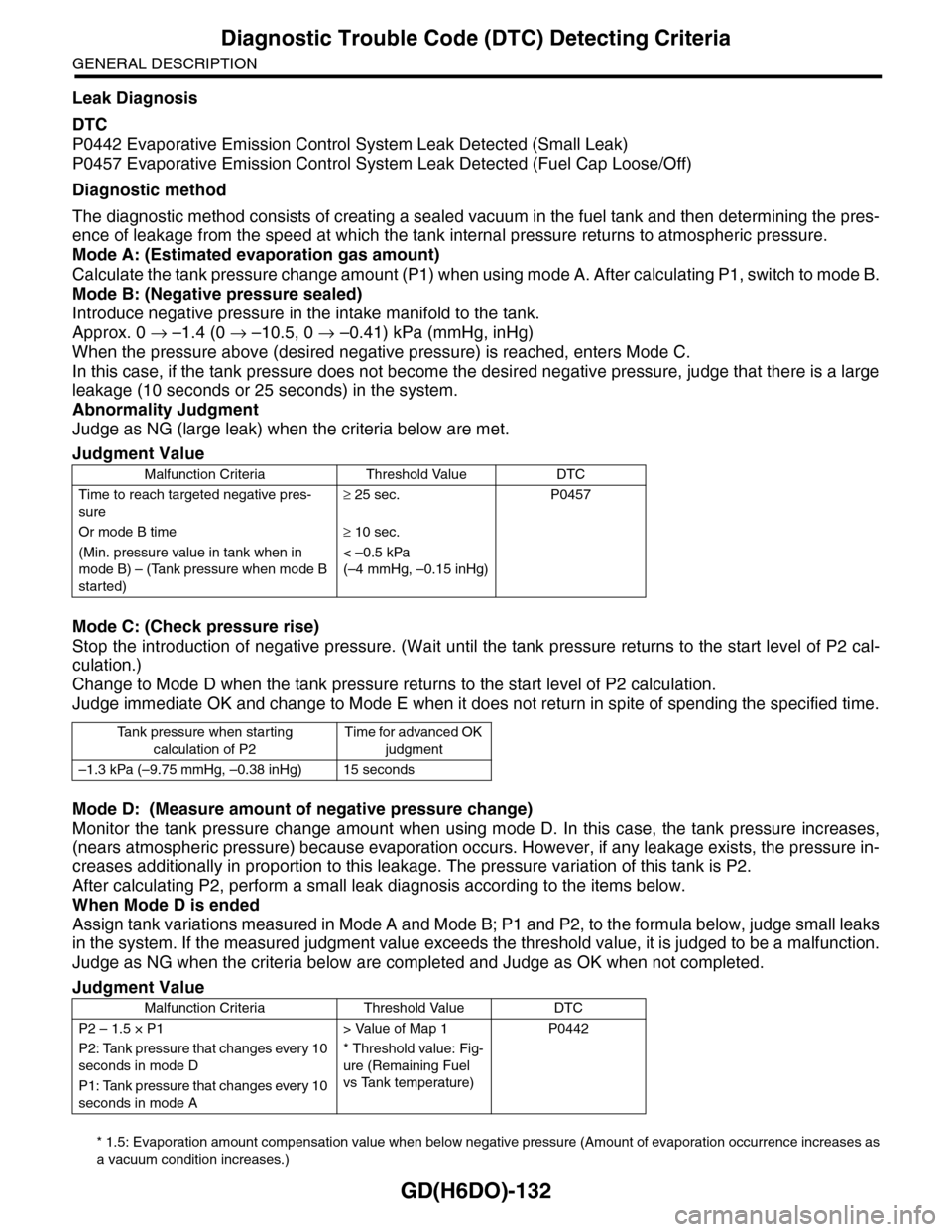
GD(H6DO)-132
Diagnostic Trouble Code (DTC) Detecting Criteria
GENERAL DESCRIPTION
Leak Diagnosis
DTC
P0442 Evaporative Emission Control System Leak Detected (Small Leak)
P0457 Evaporative Emission Control System Leak Detected (Fuel Cap Loose/Off)
Diagnostic method
The diagnostic method consists of creating a sealed vacuum in the fuel tank and then determining the pres-
ence of leakage from the speed at which the tank internal pressure returns to atmospheric pressure.
Mode A: (Estimated evaporation gas amount)
Calculate the tank pressure change amount (P1) when using mode A. After calculating P1, switch to mode B.
Mode B: (Negative pressure sealed)
Introduce negative pressure in the intake manifold to the tank.
Approx. 0 → –1.4 (0 → –10.5, 0 → –0.41) kPa (mmHg, inHg)
When the pressure above (desired negative pressure) is reached, enters Mode C.
In this case, if the tank pressure does not become the desired negative pressure, judge that there is a large
leakage (10 seconds or 25 seconds) in the system.
Abnormality Judgment
Judge as NG (large leak) when the criteria below are met.
Mode C: (Check pressure rise)
Stop the introduction of negative pressure. (Wait until the tank pressure returns to the start level of P2 cal-
culation.)
Change to Mode D when the tank pressure returns to the start level of P2 calculation.
Judge immediate OK and change to Mode E when it does not return in spite of spending the specified time.
Mode D: (Measure amount of negative pressure change)
Monitor the tank pressure change amount when using mode D. In this case, the tank pressure increases,
(nears atmospheric pressure) because evaporation occurs. However, if any leakage exists, the pressure in-
creases additionally in proportion to this leakage. The pressure variation of this tank is P2.
After calculating P2, perform a small leak diagnosis according to the items below.
When Mode D is ended
Assign tank variations measured in Mode A and Mode B; P1 and P2, to the formula below, judge small leaks
in the system. If the measured judgment value exceeds the threshold value, it is judged to be a malfunction.
Judge as NG when the criteria below are completed and Judge as OK when not completed.
* 1.5: Evaporation amount compensation value when below negative pressure (Amount of evaporation occurrence increases as
a vacuum condition increases.)
Judgment Value
Malfunction Criteria Threshold Value DTC
Time to reach targeted negative pres-
sure
≥ 25 sec. P0457
Or mode B time≥ 10 sec.
(Min. pressure value in tank when in
mode B) – (Tank pressure when mode B
started)
< –0.5 kPa
(–4 mmHg, –0.15 inHg)
Ta n k p r e s s u r e w h e n s t a r t i n g
calculation of P2
Time for advanced OK
judgment
–1.3 kPa (–9.75 mmHg, –0.38 inHg) 15 seconds
Judgment Value
Malfunction Criteria Threshold Value DTC
P2 – 1.5 × P1 > Value of Map 1 P0442
P2: Tank pressure that changes every 10
seconds in mode D
* Threshold value: Fig-
ure (Remaining Fuel
vs Tank temperature)
P1: Tank pressure that changes every 10
seconds in mode A
Page 1745 of 2453
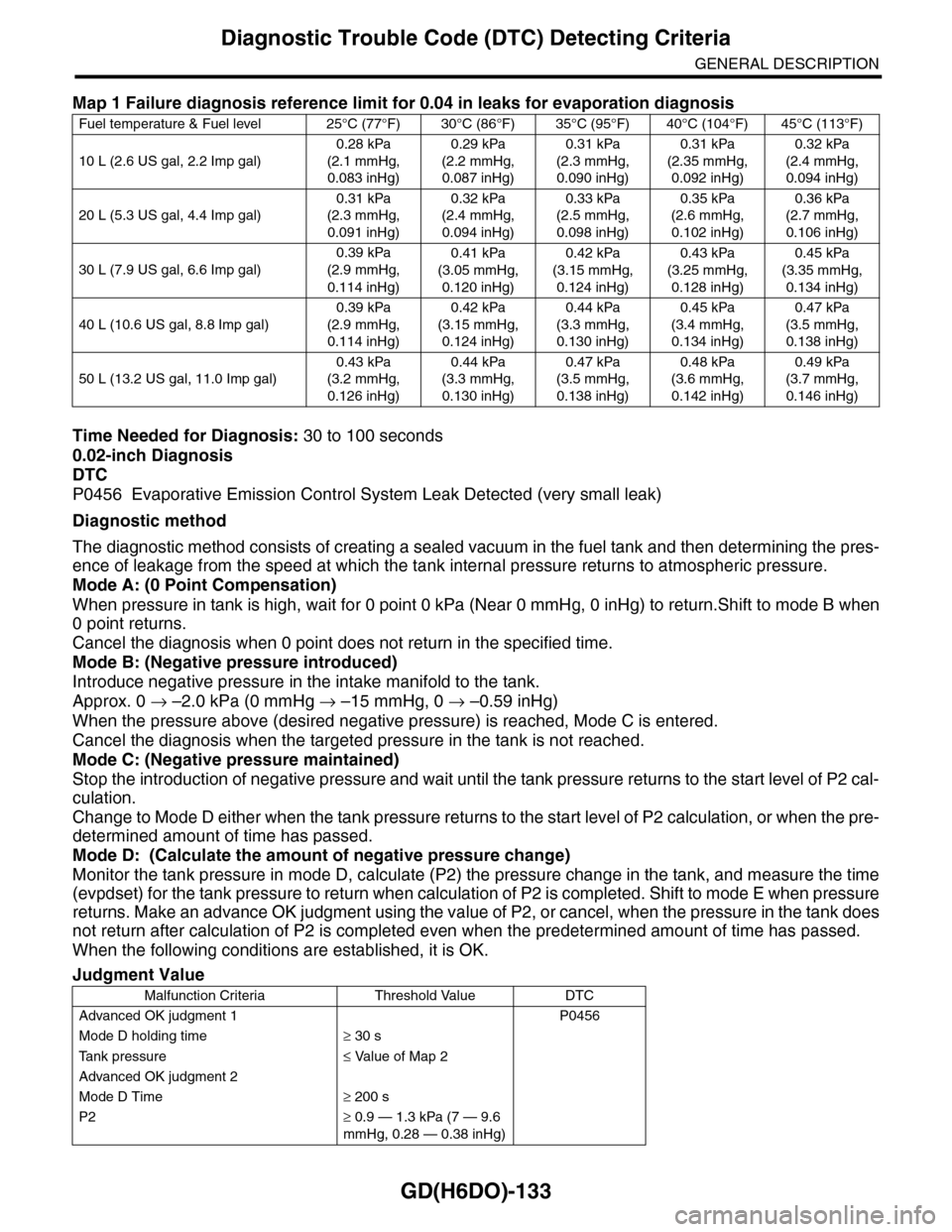
GD(H6DO)-133
Diagnostic Trouble Code (DTC) Detecting Criteria
GENERAL DESCRIPTION
Time Needed for Diagnosis: 30 to 100 seconds
0.02-inch Diagnosis
DTC
P0456 Evaporative Emission Control System Leak Detected (very small leak)
Diagnostic method
The diagnostic method consists of creating a sealed vacuum in the fuel tank and then determining the pres-
ence of leakage from the speed at which the tank internal pressure returns to atmospheric pressure.
Mode A: (0 Point Compensation)
When pressure in tank is high, wait for 0 point 0 kPa (Near 0 mmHg, 0 inHg) to return.Shift to mode B when
0 point returns.
Cancel the diagnosis when 0 point does not return in the specified time.
Mode B: (Negative pressure introduced)
Introduce negative pressure in the intake manifold to the tank.
Approx. 0 → –2.0 kPa (0 mmHg → –15 mmHg, 0 → –0.59 inHg)
When the pressure above (desired negative pressure) is reached, Mode C is entered.
Cancel the diagnosis when the targeted pressure in the tank is not reached.
Mode C: (Negative pressure maintained)
Stop the introduction of negative pressure and wait until the tank pressure returns to the start level of P2 cal-
culation.
Change to Mode D either when the tank pressure returns to the start level of P2 calculation, or when the pre-
determined amount of time has passed.
Mode D: (Calculate the amount of negative pressure change)
Monitor the tank pressure in mode D, calculate (P2) the pressure change in the tank, and measure the time
(evpdset) for the tank pressure to return when calculation of P2 is completed. Shift to mode E when pressure
returns. Make an advance OK judgment using the value of P2, or cancel, when the pressure in the tank does
not return after calculation of P2 is completed even when the predetermined amount of time has passed.
When the following conditions are established, it is OK.
Map 1 Failure diagnosis reference limit for 0.04 in leaks for evaporation diagnosis
Fuel temperature & Fuel level 25°C (77°F) 30°C (86°F) 35°C (95°F) 40°C (104°F) 45°C (113°F)
10 L (2.6 US gal, 2.2 Imp gal)
0.28 kPa
(2.1 mmHg,
0.083 inHg)
0.29 kPa
(2.2 mmHg,
0.087 inHg)
0.31 kPa
(2.3 mmHg,
0.090 inHg)
0.31 kPa
(2.35 mmHg,
0.092 inHg)
0.32 kPa
(2.4 mmHg,
0.094 inHg)
20 L (5.3 US gal, 4.4 Imp gal)
0.31 kPa
(2.3 mmHg,
0.091 inHg)
0.32 kPa
(2.4 mmHg,
0.094 inHg)
0.33 kPa
(2.5 mmHg,
0.098 inHg)
0.35 kPa
(2.6 mmHg,
0.102 inHg)
0.36 kPa
(2.7 mmHg,
0.106 inHg)
30 L (7.9 US gal, 6.6 Imp gal)
0.39 kPa
(2.9 mmHg,
0.114 inHg)
0.41 kPa
(3.05 mmHg,
0.120 inHg)
0.42 kPa
(3.15 mmHg,
0.124 inHg)
0.43 kPa
(3.25 mmHg,
0.128 inHg)
0.45 kPa
(3.35 mmHg,
0.134 inHg)
40 L (10.6 US gal, 8.8 Imp gal)
0.39 kPa
(2.9 mmHg,
0.114 inHg)
0.42 kPa
(3.15 mmHg,
0.124 inHg)
0.44 kPa
(3.3 mmHg,
0.130 inHg)
0.45 kPa
(3.4 mmHg,
0.134 inHg)
0.47 kPa
(3.5 mmHg,
0.138 inHg)
50 L (13.2 US gal, 11.0 Imp gal)
0.43 kPa
(3.2 mmHg,
0.126 inHg)
0.44 kPa
(3.3 mmHg,
0.130 inHg)
0.47 kPa
(3.5 mmHg,
0.138 inHg)
0.48 kPa
(3.6 mmHg,
0.142 inHg)
0.49 kPa
(3.7 mmHg,
0.146 inHg)
Judgment Value
Malfunction Criteria Threshold Value DTC
Advanced OK judgment 1 P0456
Mode D holding time≥ 30 s
Ta n k p r e s s u r e≤ Value of Map 2
Advanced OK judgment 2
Mode D Time≥ 200 s
P2≥ 0.9 — 1.3 kPa (7 — 9.6
mmHg, 0.28 — 0.38 inHg)
Page 1746 of 2453

GD(H6DO)-134
Diagnostic Trouble Code (DTC) Detecting Criteria
GENERAL DESCRIPTION
Mode E: (Evaporation occurrence amount calculation)
Calculate the change of tank pressure with the time evpdset to Judge as NG/OK according to the value of P1.
(ambiguous determination acceptable.)
Abnormality Judgment
When the following conditions are established, it is NG.
Map 2 Fuel level and corresponding tank pressure
Fuel level
10 L (2.6 US
gal, 2.2 Imp
gal)
20 L (5.3 US
gal, 4.4 Imp
gal)
30 L (7.9 US
gal, 6.6 Imp
gal)
40 L (10.6 US
gal, 8.8 Imp
gal)
50 L (13.2 US
gal, 11.0 Imp
gal)
Ta n k p r e s s u r e
–1.8 kPa
(–13.5 mmHg,
–0.53 inHg)
–1.77 kPa
(–13.3 mmHg,
–0.52 inHg)
–1.75 kPa
(–13.1 mmHg,
–0.52 inHg)
–1.67 kPa
(–12.5 mmHg,
–0.49 inHg)
–1.6 kPa
(–12 mmHg, –
0.47 inHg)
Judgment Value
Malfunction Criteria Threshold Value DTC
P1 < Value of Map 3
* Threshold value: Fig-
ure (Residual Fuel
Amount vs evpdset)
P0456
Map 3 Failure diagnosis reference limit for 0.02 in leaks for evaporative emission control system di-
agnosis
Time evpdset & Fuel level 0 seconds 50 seconds 65 seconds 120 seconds 150 seconds 200 seconds
10 L (2.6 US gal, 2.2 Imp gal)
0 kPa
(0 mmHg,
0 inHg)
0.19 kPa
(1.4 mmHg,
0.056 inHg)
0.25 kPa
(1.84 mmHg,
0.074 inHg)
0.25 kPa
(1.84 mmHg,
0.074 inHg)
0.25 kPa
(1.84 mmHg,
0.074 inHg)
0.25 kPa
(1.84 mmHg,
0.074 inHg)
20 L (5.3 US gal, 4.4 lmp gal)
0 kPa
(0 mmHg,
0 inHg)
0.21 kPa
(1.54 mmHg,
0.062 inHg)
0.23 kPa
(1.76 mmHg,
0.068 inHg)
0.23 kPa
(1.76 mmHg,
0.068 inHg)
0.23 kPa
(1.76 mmHg,
0.068 inHg)
0.23 kPa
(1.76 mmHg,
0.068 inHg)
30 L (7.9 US gal, 6.6 lmp gal)
0 kPa
(0 mmHg,
0 inHg)
0.22 kPa
(1.68 mmHg,
0.065 inHg)
0.22 kPa
(1.68 mmHg,
0.065 inHg)
0.22 kPa
(1.68 mmHg,
0.065 inHg)
0.22 kPa
(1.68 mmHg,
0.065 inHg)
0.22 kPa
(1.68 mmHg,
0.065 inHg)
40 L (10.6 US gal, 8.8 lmp
gal)
0 kPa
(0 mmHg,
0 inHg)
0.18 kPa
(1.315 mmHg,
0.053 inHg)
0.18 kPa
(1.315 mmHg,
0.053 inHg)
0.18 kPa
(1.315 mmHg,
0.053 inHg)
0.18 kPa
(1.315 mmHg,
0.053 inHg)
0.18 kPa
(1.315 mmHg,
0.053 inHg)
50 L (13.2 US gal, 11.0 lmp
gal)
0 kPa
(0 mmHg,
0 inHg)
0.13 kPa
(0.95 mmHg,
0.038 inHg)
0.13 kPa
(0.95 mmHg,
0.038 inHg)
0.13 kPa
(0.95 mmHg,
0.038 inHg)
0.13 kPa
(0.95 mmHg,
0.038 inHg)
0 kPa
(0 mmHg,
0 inHg)
Page 1747 of 2453
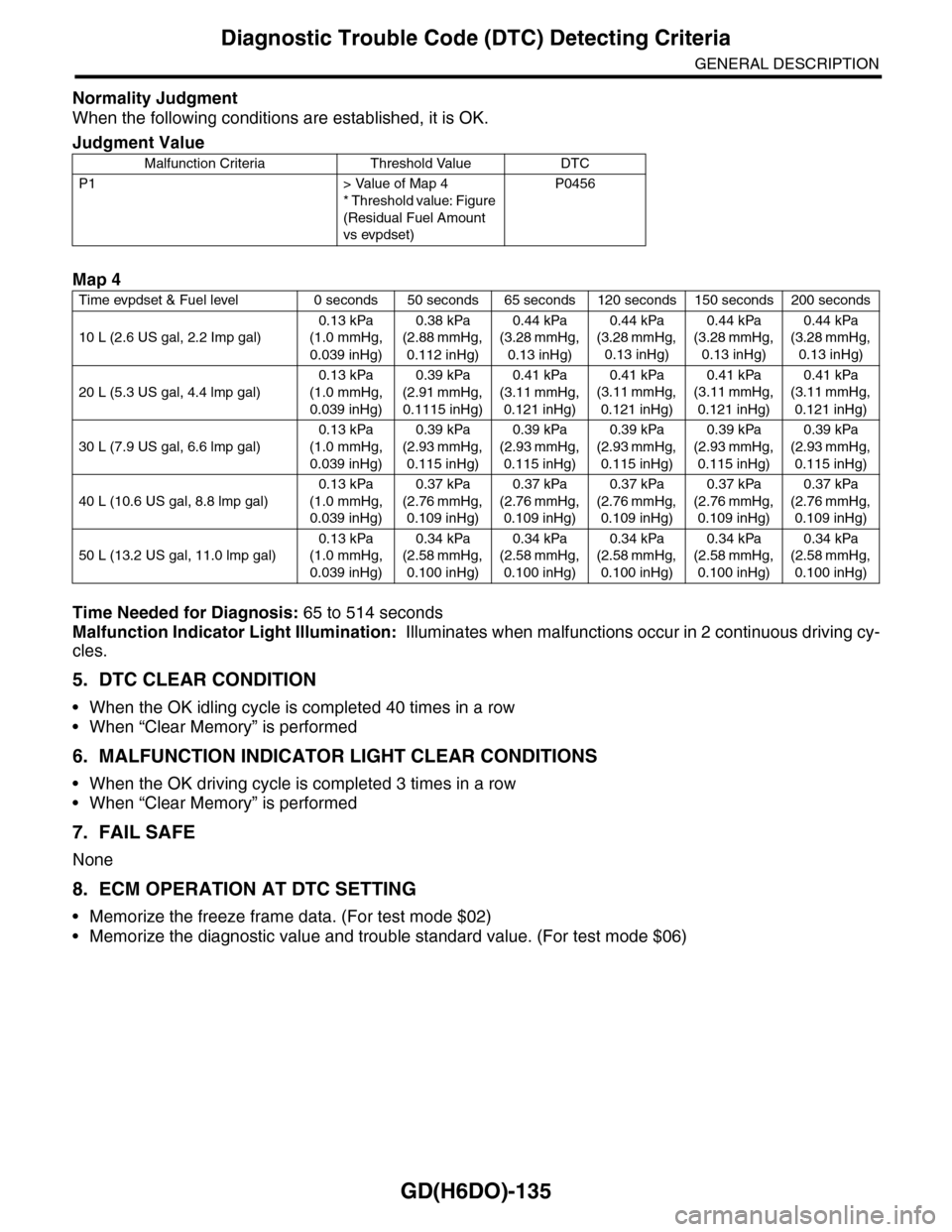
GD(H6DO)-135
Diagnostic Trouble Code (DTC) Detecting Criteria
GENERAL DESCRIPTION
Normality Judgment
When the following conditions are established, it is OK.
Time Needed for Diagnosis: 65 to 514 seconds
Malfunction Indicator Light Illumination: Illuminates when malfunctions occur in 2 continuous driving cy-
cles.
5. DTC CLEAR CONDITION
•When the OK idling cycle is completed 40 times in a row
•When “Clear Memory” is performed
6. MALFUNCTION INDICATOR LIGHT CLEAR CONDITIONS
•When the OK driving cycle is completed 3 times in a row
•When “Clear Memory” is performed
7. FAIL SAFE
None
8. ECM OPERATION AT DTC SETTING
•Memorize the freeze frame data. (For test mode $02)
•Memorize the diagnostic value and trouble standard value. (For test mode $06)
Judgment Value
Malfunction Criteria Threshold Value DTC
P1 > Value of Map 4
* Threshold value: Figure
(Residual Fuel Amount
vs evpdset)
P0456
Map 4
Time evpdset & Fuel level 0 seconds 50 seconds 65 seconds 120 seconds 150 seconds 200 seconds
10 L (2.6 US gal, 2.2 Imp gal)
0.13 kPa
(1.0 mmHg,
0.039 inHg)
0.38 kPa
(2.88 mmHg,
0.112 inHg)
0.44 kPa
(3.28 mmHg,
0.13 inHg)
0.44 kPa
(3.28 mmHg,
0.13 inHg)
0.44 kPa
(3.28 mmHg,
0.13 inHg)
0.44 kPa
(3.28 mmHg,
0.13 inHg)
20 L (5.3 US gal, 4.4 lmp gal)
0.13 kPa
(1.0 mmHg,
0.039 inHg)
0.39 kPa
(2.91 mmHg,
0.1115 inHg)
0.41 kPa
(3.11 mmHg,
0.121 inHg)
0.41 kPa
(3.11 mmHg,
0.121 inHg)
0.41 kPa
(3.11 mmHg,
0.121 inHg)
0.41 kPa
(3.11 mmHg,
0.121 inHg)
30 L (7.9 US gal, 6.6 lmp gal)
0.13 kPa
(1.0 mmHg,
0.039 inHg)
0.39 kPa
(2.93 mmHg,
0.115 inHg)
0.39 kPa
(2.93 mmHg,
0.115 inHg)
0.39 kPa
(2.93 mmHg,
0.115 inHg)
0.39 kPa
(2.93 mmHg,
0.115 inHg)
0.39 kPa
(2.93 mmHg,
0.115 inHg)
40 L (10.6 US gal, 8.8 lmp gal)
0.13 kPa
(1.0 mmHg,
0.039 inHg)
0.37 kPa
(2.76 mmHg,
0.109 inHg)
0.37 kPa
(2.76 mmHg,
0.109 inHg)
0.37 kPa
(2.76 mmHg,
0.109 inHg)
0.37 kPa
(2.76 mmHg,
0.109 inHg)
0.37 kPa
(2.76 mmHg,
0.109 inHg)
50 L (13.2 US gal, 11.0 lmp gal)
0.13 kPa
(1.0 mmHg,
0.039 inHg)
0.34 kPa
(2.58 mmHg,
0.100 inHg)
0.34 kPa
(2.58 mmHg,
0.100 inHg)
0.34 kPa
(2.58 mmHg,
0.100 inHg)
0.34 kPa
(2.58 mmHg,
0.100 inHg)
0.34 kPa
(2.58 mmHg,
0.100 inHg)
Page 1752 of 2453
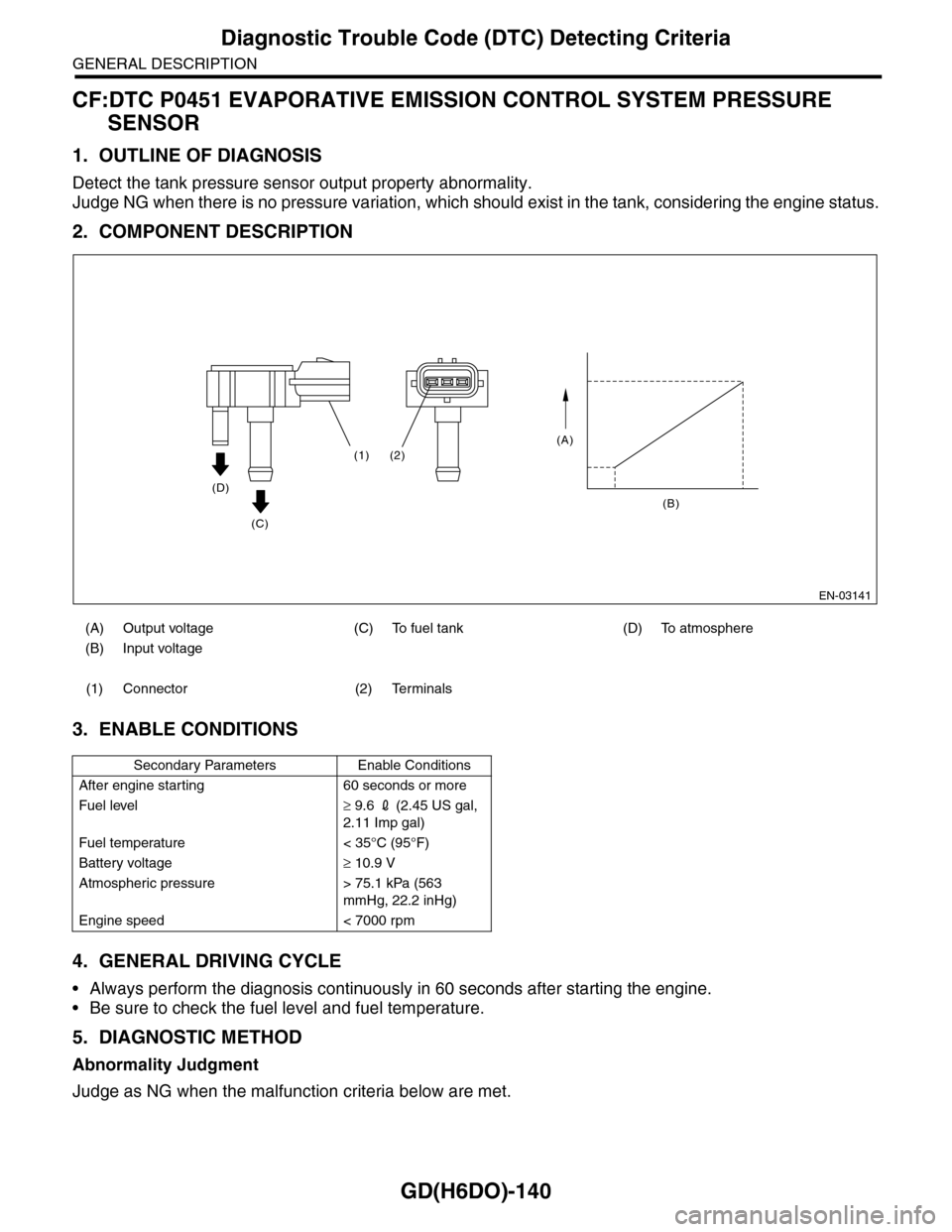
GD(H6DO)-140
Diagnostic Trouble Code (DTC) Detecting Criteria
GENERAL DESCRIPTION
CF:DTC P0451 EVAPORATIVE EMISSION CONTROL SYSTEM PRESSURE
SENSOR
1. OUTLINE OF DIAGNOSIS
Detect the tank pressure sensor output property abnormality.
Judge NG when there is no pressure variation, which should exist in the tank, considering the engine status.
2. COMPONENT DESCRIPTION
3. ENABLE CONDITIONS
4. GENERAL DRIVING CYCLE
•Always perform the diagnosis continuously in 60 seconds after starting the engine.
•Be sure to check the fuel level and fuel temperature.
5. DIAGNOSTIC METHOD
Abnormality Judgment
Judge as NG when the malfunction criteria below are met.
(A) Output voltage (C) To fuel tank (D) To atmosphere
(B) Input voltage
(1) Connector (2) Terminals
Secondary Parameters Enable Conditions
After engine starting 60 seconds or more
Fuel level≥ 9.6 2 (2.45 US gal,
2.11 Imp gal)
Fuel temperature < 35°C (95°F)
Battery voltage≥ 10.9 V
Atmospheric pressure > 75.1 kPa (563
mmHg, 22.2 inHg)
Engine speed < 7000 rpm
EN-03141
(A)
(B)
(2)(1)
(D)
(C)
Page 1753 of 2453
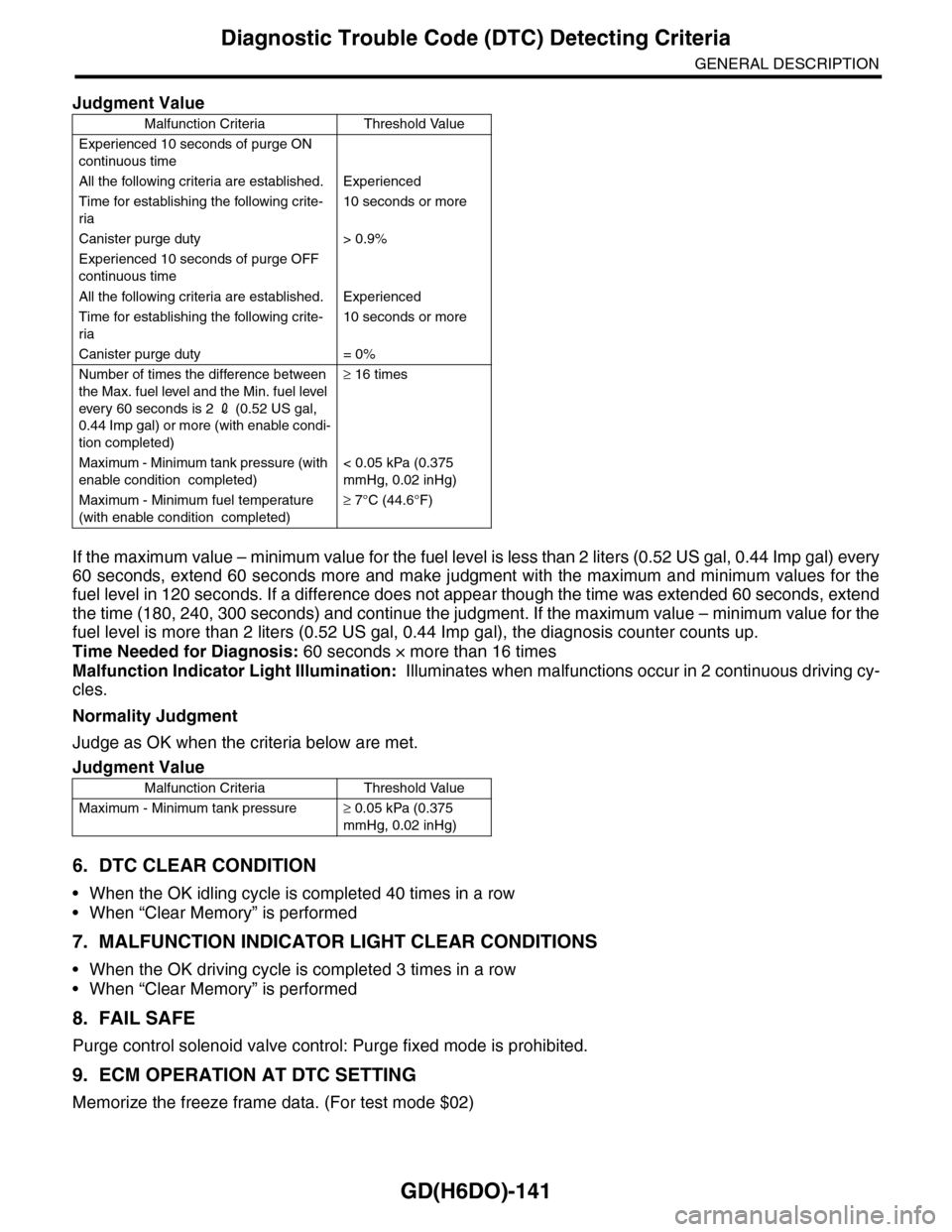
GD(H6DO)-141
Diagnostic Trouble Code (DTC) Detecting Criteria
GENERAL DESCRIPTION
If the maximum value – minimum value for the fuel level is less than 2 liters (0.52 US gal, 0.44 Imp gal) every
60 seconds, extend 60 seconds more and make judgment with the maximum and minimum values for the
fuel level in 120 seconds. If a difference does not appear though the time was extended 60 seconds, extend
the time (180, 240, 300 seconds) and continue the judgment. If the maximum value – minimum value for the
fuel level is more than 2 liters (0.52 US gal, 0.44 Imp gal), the diagnosis counter counts up.
Time Needed for Diagnosis: 60 seconds × more than 16 times
Malfunction Indicator Light Illumination: Illuminates when malfunctions occur in 2 continuous driving cy-
cles.
Normality Judgment
Judge as OK when the criteria below are met.
6. DTC CLEAR CONDITION
•When the OK idling cycle is completed 40 times in a row
•When “Clear Memory” is performed
7. MALFUNCTION INDICATOR LIGHT CLEAR CONDITIONS
•When the OK driving cycle is completed 3 times in a row
•When “Clear Memory” is performed
8. FAIL SAFE
Purge control solenoid valve control: Purge fixed mode is prohibited.
9. ECM OPERATION AT DTC SETTING
Memorize the freeze frame data. (For test mode $02)
Judgment Value
Malfunction Criteria Threshold Value
Experienced 10 seconds of purge ON
continuous time
All the following criteria are established. Experienced
Time for establishing the following crite-
ria
10 seconds or more
Canister purge duty > 0.9%
Experienced 10 seconds of purge OFF
continuous time
All the following criteria are established. Experienced
Time for establishing the following crite-
ria
10 seconds or more
Canister purge duty = 0%
Number of times the difference between
the Max. fuel level and the Min. fuel level
ever y 60 seconds is 2 2 (0.52 US gal,
0.44 Imp gal) or more (with enable condi-
tion completed)
≥ 16 times
Maximum - Minimum tank pressure (with
enable condition completed)
< 0.05 kPa (0.375
mmHg, 0.02 inHg)
Maximum - Minimum fuel temperature
(with enable condition completed)
≥ 7°C (44.6°F)
Judgment Value
Malfunction Criteria Threshold Value
Maximum - Minimum tank pressure≥ 0.05 kPa (0.375
mmHg, 0.02 inHg)
Page 1754 of 2453
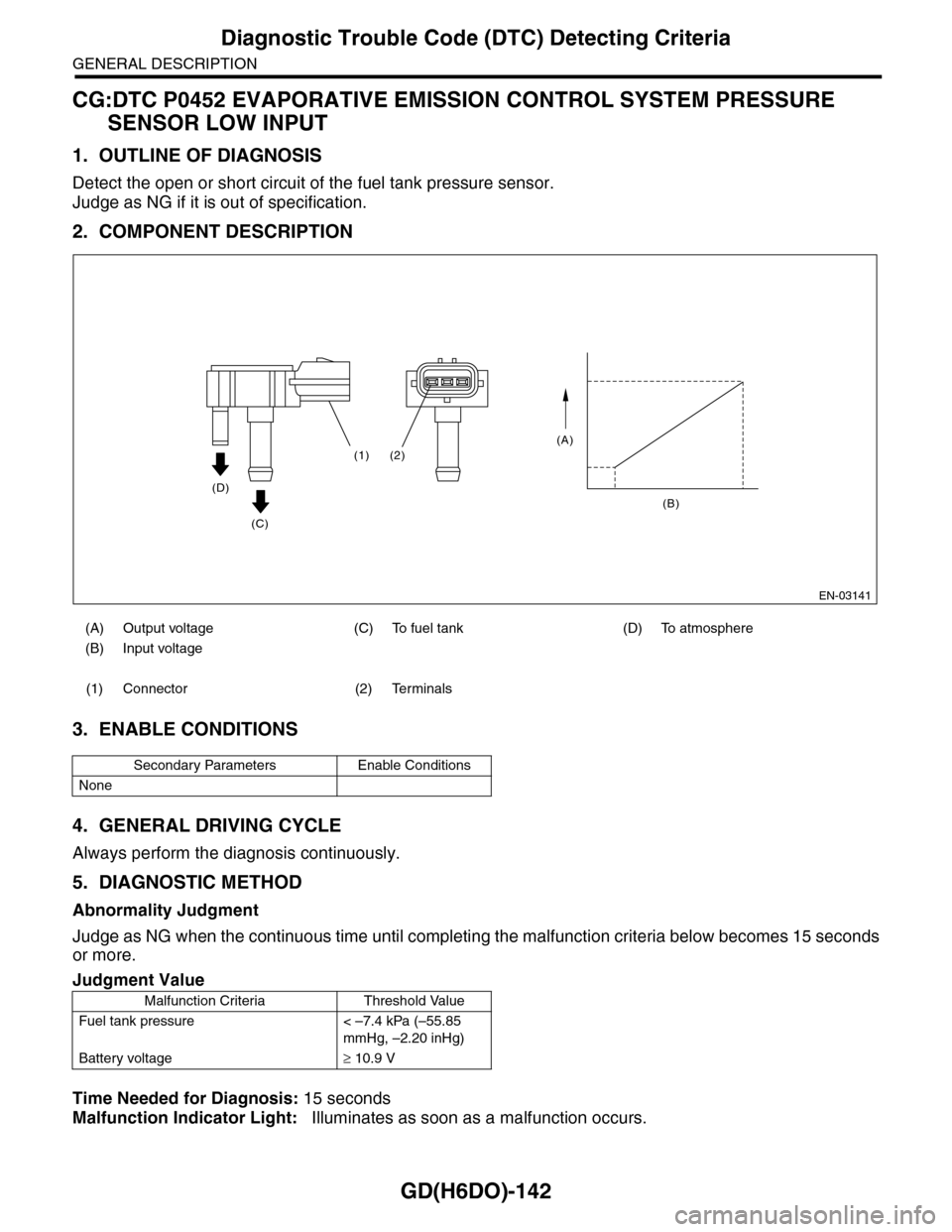
GD(H6DO)-142
Diagnostic Trouble Code (DTC) Detecting Criteria
GENERAL DESCRIPTION
CG:DTC P0452 EVAPORATIVE EMISSION CONTROL SYSTEM PRESSURE
SENSOR LOW INPUT
1. OUTLINE OF DIAGNOSIS
Detect the open or short circuit of the fuel tank pressure sensor.
Judge as NG if it is out of specification.
2. COMPONENT DESCRIPTION
3. ENABLE CONDITIONS
4. GENERAL DRIVING CYCLE
Always perform the diagnosis continuously.
5. DIAGNOSTIC METHOD
Abnormality Judgment
Judge as NG when the continuous time until completing the malfunction criteria below becomes 15 seconds
or more.
Time Needed for Diagnosis: 15 seconds
Malfunction Indicator Light: Illuminates as soon as a malfunction occurs.
(A) Output voltage (C) To fuel tank (D) To atmosphere
(B) Input voltage
(1) Connector (2) Terminals
Secondary Parameters Enable Conditions
None
Judgment Value
Malfunction Criteria Threshold Value
Fuel tank pressure < –7.4 kPa (–55.85
mmHg, –2.20 inHg)
Battery voltage≥ 10.9 V
EN-03141
(A)
(B)
(2)(1)
(D)
(C)
Page 1755 of 2453
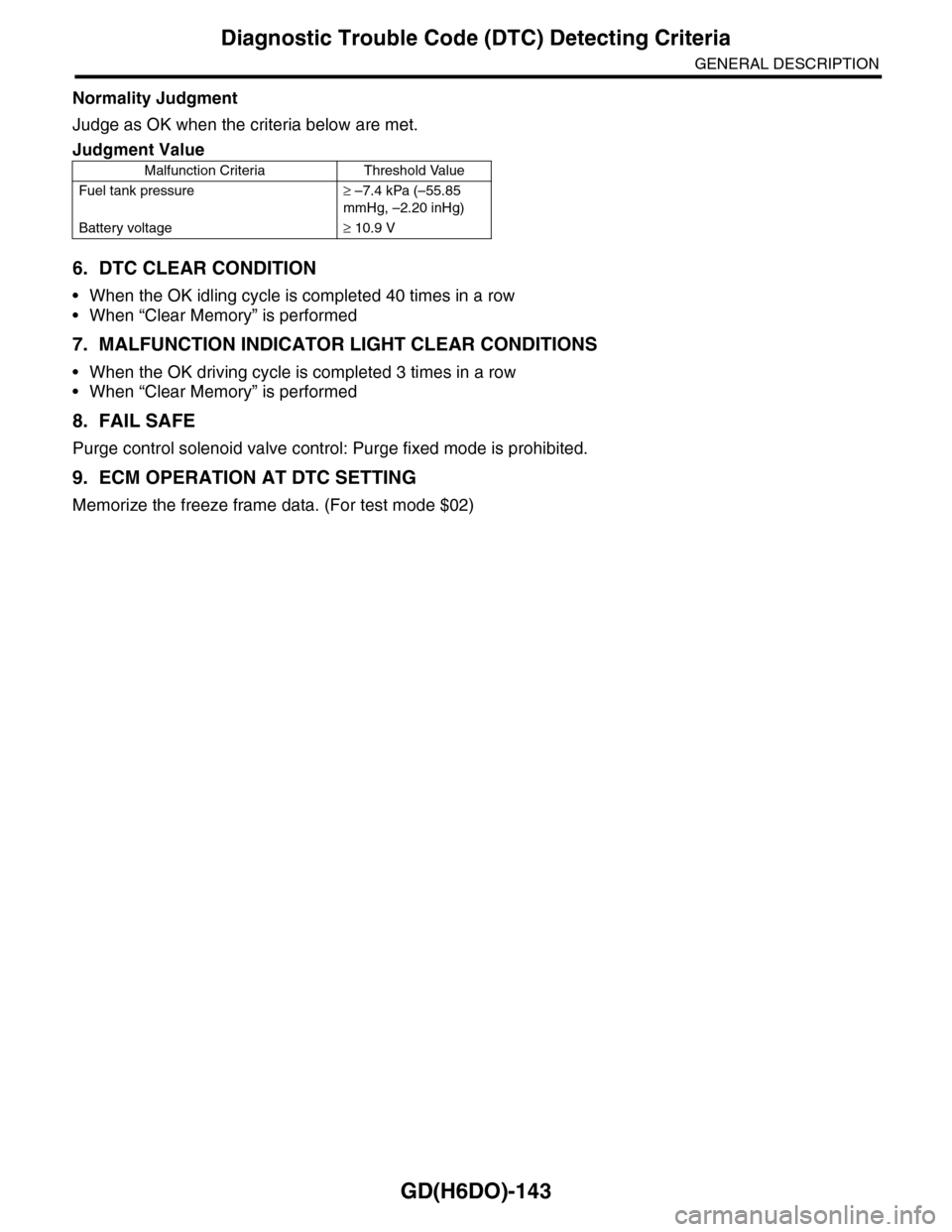
GD(H6DO)-143
Diagnostic Trouble Code (DTC) Detecting Criteria
GENERAL DESCRIPTION
Normality Judgment
Judge as OK when the criteria below are met.
6. DTC CLEAR CONDITION
•When the OK idling cycle is completed 40 times in a row
•When “Clear Memory” is performed
7. MALFUNCTION INDICATOR LIGHT CLEAR CONDITIONS
•When the OK driving cycle is completed 3 times in a row
•When “Clear Memory” is performed
8. FAIL SAFE
Purge control solenoid valve control: Purge fixed mode is prohibited.
9. ECM OPERATION AT DTC SETTING
Memorize the freeze frame data. (For test mode $02)
Judgment Value
Malfunction Criteria Threshold Value
Fuel tank pressure≥ –7.4 kPa (–55.85
mmHg, –2.20 inHg)
Battery voltage≥ 10.9 V